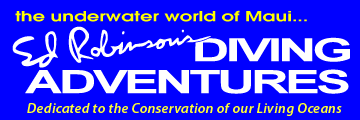Videolights
Diving Heroes
Known & Unknown
by Roger Roth
Everyone has heroes in their lives and this includes our heroes in the diving industry. Many of us grew up hoping to someday meet Jacques Cousteau or even Lloyd Bridges. People like these obviously left their marks on our lives one way or another.
Jacques Cousteau’s legacy in diving is one with which we are all familiar. But many may not be aware of his philosophical outlooks on life in general. With more in-depth study of his life, one can learn about these aspects, gaining even more respect for this hero.
When asked, “What is the joy of living?” Jacques stated that, “Joy comes mainly from sharing. Sharing what you have shows your love, and love is not only sharing what you have but sharing yourself with others. Each time you forget yourself to think of others, you’re reaching a joyful way of life.”
When Jacques passed away, I was personally disappointed that I would not have the opportunity to dive and/or associate with him as one of my heroes. But for me, a dive trip on the Cayman Aggressor in 1998 turned into an expedition with Jacques’ son, Jean-Michel. That was as good as it was going to get and turned out to be quite exciting.
Jean-Michel was aboard on that trip diving and teaching a lot about marine biology, marine behavior, and conservation in between dives and during evening presentations. Unbeknownst to me, he was also checking out the 3 or 4 videographers on board. Halfway through the week, he pulled me aside and asked if I’d be willing to document his second anniversary survey of the Russian Destroyer (MV. Tibbetts) that was purposely sunk off Cayman Brac as an artificial reef.
As much as I though of telling him I’d have to look at my schedule to see if I could fit it in, my mouth immediately responded, “Absolutely!” Filming for a Cousteau production was surely a dream come true for me. And the fact that he paid me enough for the footage use to cover my trip made it even better!
Another Aggressor trip in Fiji hooked me up with Stan Waterman. Being a filmmaker myself made this meeting very special to me and I came away from that trip with a lot of new knowledge about shooting as well as better techniques with lighting. Best of all, Stan became a continuing mentor to me and to this day he won’t hesitate to support my work.
From the time I began diving and shooting video underwater in 1988, I eagerly seeked out and read every Skin Diver magazine I could get my hands on in order to study Jim Church’s monthly articles on underwater video. Through the years I applied Jim’s techniques to my experience and began entering various international underwater video competitions. To my delight, in a matter of ten years I’d earned nine international first place awards and countless seconds and thirds.
On a whim in 1998, I contacted Jim to request that he consider doing a photo workshop for an annual ScubaFest dive show in Ohio. He graciously accepted, and on the drive from the airport I mentioned that he’d been a judge in many of the competitions in which I’d won or placed. When he asked me why I thought that was, I replied I had no doubt it was because I’d learned his style from reading all of his articles! He obviously agreed.
Since then Jim never hesitated to take the time to critique and grade many of my productions as his time permitted. After years of his mentoring, I asked him why he was willing to do this for me even though I’d never traveled with him or paid him. He sincerely explained that it was his way of giving back to the industry and he was confident that I would do the same, passing it along.
On a recent return flight from diving in Grand Cayman, I took my seat next to a distinguished gentleman who was surely in his late 80’s, and I remembered seeing him board the plane earlier in a wheelchair. We pleasantly greeted each other as I stashed my backpack under the seat in front of me. I pulled out my Sudoku book and settled in for the flight.
About 15 minutes later, he apologized for interrupting me and asked about my earring. I told him it was not an interruption and explained that it was my logo, back-to-back “R’s” for Roger Roth. He smiled and said he liked that.
Then he asked me what I was doing in Grand Cayman and I told him I was filming underwater. He got very excited about that and asked more questions like what I did with my footage and if this was a hobby or a job. It seemed to me that he was interested in learning about underwater stuff and I told him I produced promo videos for dive destinations all over the world, educational videos for presentations in schools and senior centers, and had done shoots for a Discovery Channel program, the U.S. Navy, the Nature Conservancy, and more.
We both were enjoying the conversation together as he proceeded to tell me he finally got to do something in Grand Cayman he’d always wanted to do. I asked him what that was and he replied that he finally got to go to Stingray City. Thinking that he probably didn’t dive or even snorkel, I guessed in my mind that he probably watched from the boat as his family either dived or snorkeled with the stingrays.
Then he proceeded to tell me that he was much more comfortable doing a 300’ dive with a competent line tender that he was on regular scuba gear. At that point, I’m sure my mouth dropped. As I picked my self up off the floor I asked him what he meant.
To make a long story short, that’s when he introduced himself as Homer Fletcher and showed me his NAUI C-card documenting over 6,000 dives (now 6032). For the remainder of the trip I was in awe as he told me about the professionals in the industry that he knows dating back to 1950 and before, some of the training techniques he’s used through the decades as a NAUI instructor (as well as author of the NAUI training manual), and also about his wife Suzie who is in the Women Divers Hall of Fame.
As we readied to deplane, he asked if I’d send him some of my productions. I handed him 3 DVD’s I happened to have in my backpack. He seemed almost as excited about receiving those DVD’s as I was having made a new friend and finding a new hero. Sea Ya!
Critter corner: To pet a stingray that’s laying in the sand, a diver needs to lay in the sand him/herself and approach the side of the ray slowly inch by inch and in an unthreatening manner. Once within arm’s reach, the diver should slowly reach their hand at sand level towards the ray’s pectoral (side) fin. Touch and caress softly, then slowly pull your hand back to keep the ray calm. (Of course, I take no responsibility for anyone trying this and getting hurt; it’s just the way I do it knowing I could get hurt and taking full responsibility for myself. If the ray doesn’t want this interaction it will usually just leave before it will attack.)
copyright © Roger Roth, 2002 - 2011
Roger Roth is a roofer by trade and lives in Cincinnati, Ohio. But his passion is underwater vidiography and after several decades of learning how to shoot and edit he has evolved into a teacher and a photographic philanthropist. Roger is the founder of the annual international Underwater Images Photo and Video Competition. You may contact Roger at rroth2@cinci.rr.com.

